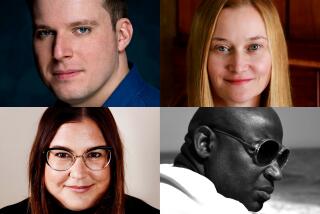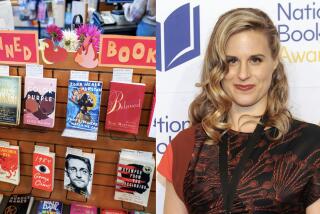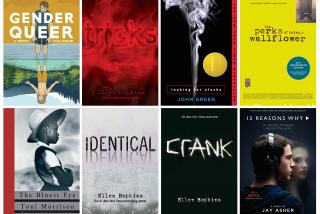Children’s literature is a fast-growing genre thanks to ‘Potter’ & Co.
For years, the book industry has been mired in debates about the plight of independent booksellers, the rise of Amazon and the fate of print as it struggles with the relentless march of technology. But doom-and-gloomers forecasting “the end of books” probably haven’t strolled through the children’s section lately or considered what’s coming this season, from picture books through titles for teens.
This fall’s offerings span a wide variety of topics and suggest why children’s books have turned into the fastest-growing segment of the publishing industry.
The magical spell J.K. Rowling cast over kid lit with “Harry Potter” found new blood with Stephenie Meyer’s “Twilight” saga and most recently, Suzanne Collins’ fight-to-the-death “The Hunger Games,” creating a halo effect for the entire genre that doesn’t show any signs of slowing. Last year, overall publisher revenues for children’s books were up 12%, to $2.78 billion, and e-books made astounding gains, according to BookStats, a collaboration of the Assn. of American Publishers and the Book Industry Study Group.
This year is no different. It used to be that when readers finished a groundbreaking series, they struggled to find others with similar appeal. No more. The millions of readers who followed Bella as she pursued supernatural true love or Katniss as she navigated a post-apocalyptic U.S. can now find dozens of bestselling paranormal and dystopian series that will see further installments this fall.
Similarly, in the middle-grade space, Jeff Kinney’s “Diary of a Wimpy Kid” has opened up a whole genre of illustrated, humorous, confessional-style bestsellers, which will continue in the coming months.
That’s to say nothing of the increasing numbers of celebrities and well-known adult-book authors who are applying their talents to younger readerships this season — including Emma Thompson with a Peter Rabbit picture book and Elizabeth George with her young adult debut — and legions of talented unknowns who are likely to score hits with their children’s book debuts, such as Stefan Bachmann and his buzzed-about fairy tale, “The Peculiar,” and Fiona Paul’s Renaissance murder-romance, “Venom.” In fact, many forthcoming children’s books have already been snatched up by movie studios.
The young adult, or YA, category is particularly healthy as a result of blockbuster franchises and strong crossover readership. Many young adult books are read as much by adults as they are by their intended teen audiences.
Scholastic reports that 50% of the readers of “The Hunger Games” are adults. And more than half of the readers of the bestseller “Divergent” by Veronica Roth are at least 25 years old, according to a HarperCollins spokeswoman.
The stigma of adults “reading down” with children’s titles is gone, said David Levithan, editorial director of Scholastic Press, which also published the Harry Potter series in the U.S.
“Adults have no hesitation at all to buy young adult anymore, so it’s very easy to cross over,” said Levithan, who anticipates high adult readership for “The Raven Boys,” a mythological paranormal thriller kicking off a four-book series by “Shiver” trilogy author Maggie Stiefvater, another Scholastic writer.
Like “The Raven Boys,” many of the most anticipated titles for fall hybridize genres. Libba Bray’s “Diviners,” for example, is paranormal historical fiction that follows a young woman during the Roaring ‘20s who becomes embroiled in an occult-related murder mystery.
Paramount has already optioned Bray’s book for film, which shows that readers aren’t the only ones interested in what’s coming.
“We’re finding as much interest from networks and studios. They are so hungry for teen content they’re acquiring rights even before the books come out,” said Susan Katz, president and publisher of HarperCollins Children’s Books. On Tuesday, the publisher will release “Don’t Turn Around” from debut author Michelle Gagnon. The thriller, about a teen computer hacker, has already been optioned for television.
“What seems to be different about the teen market as opposed to adult fiction is that young, first-time authors have a wide-open opportunity to sell like gangbusters,” Katz said.
Roth was in college when she began writing “Divergent,” the first book in a trilogy that will conclude next year. The series, which has sold 2 million copies since it began in May 2011, was recently optioned by Summit Entertainment, the production studio that brought Meyer’s “Twilight” saga to the big screen.
Although overshadowed by the crossover appeal and attention paid to young adult books, the middle-grade, or tween, category for readers ages 8 to 12 is drawing a growing number of talented authors.
More than half the books listed on industry magazine Publishers Weekly’s most recent bestseller lists for children’s fiction fall into this category. A slew of celebrities are now penning books for tweens, including James Patterson with his “Middle School” series, John Grisham with “Theodore Boone” and Colin Meloy of indie rock band the Decemberists, whose “Wildwood” series has been optioned by Laika Studios and who continues with a second book next month that takes his young protagonists into a fairy-tale underground realm in “Under Wildwood.”
This fall also sees the release of several highly anticipated sequels in bestselling series, including new installments in Kinney’s “Diary of a Wimpy Kid,” Dav Pilkey’s “Captain Underpants” and “Big Nate” by Lincoln Peirce.
Scholastic is launching a new multimedia series for tweens that can be experienced as a book, video game or both, similar to the publisher’s bestselling “39 Clues” series.
Another big factor behind increasing sales for children’s books is the popularity of e-books. At the young adult level, e-books are mostly digitized versions of print books. For middle-grade readers, said HarperCollins’ Katz, digital content does well only when it’s “enhanced” and deepens the experience and connections kids have with well-known characters, such as “Warriors” and “Big Nate.”
Though print picture books are selling well, many picture book publishers have been slow to embrace digitization, driven in part by parents’ reluctance to place a $400 e-reader device in the hands of a toddler, who might drop it.
“There’s a desire among parents to spend time reading physical books with their kids,” said John Mendelson, senior vice president of sales and digital initiatives for Candlewick, which will publish “This Is Not My Hat,” a follow-up to Jon Klassen’s picture book “I Want My Hat Back,” this fall. “There’s a real tactile element to that engagement — sitting together and turning the page with a book in your lap. Not that it can’t be done on an iPad, but there are a lot of distractions inherent with a tablet. Little kids know with the touch of a button they can be looking at a movie or playing a game.”
What’s selling for Candlewick are classics and contemporary crossovers with a modern aesthetic and a sense of humor.
For Sharon Hearn, owner of Children’s Book World in West L.A., every genre has been flourishing in recent months. The store had suffered such steep sales declines between 2008 and 2011 that Hearn, who’s run the shop for 25 years, didn’t take a salary for almost two years.
But “the first two quarters of this year have been the highest we’ve had in three years,” said Hearn, adding that picture books are her bestsellers because publishers are being more selective and producing higher-quality titles that appeal to older, more affluent parents who are willing to invest in books.
What titles is Hearn looking forward to in the fall?
The new Jamie Lee Curtis picture book, “My Brave Year of Firsts,” and Pilkey’s latest “Captain Underpants” installment, which she says the store will celebrate by hosting signings.
More to Read
The biggest entertainment stories
Get our big stories about Hollywood, film, television, music, arts, culture and more right in your inbox as soon as they publish.
You may occasionally receive promotional content from the Los Angeles Times.






